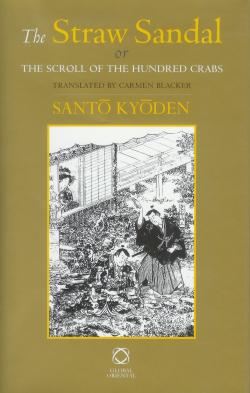The Straw Sandal or The Scroll of the Hundred Crabs

ISBN 978-1-905246-64-9, pages 166, Global Oriental, 2008, price £35 (but Japan Society members can order direct from the publishers at a discount)
Review by Sir Hugh Cortazzi
This book was launched at Daiwa House in London on 22 January. Peter Kornicki, Professor of Japanese at Cambridge University, and Dr James McMullen, a former pupil of Carmen and a lecturer in Japanese literature at Oxford University, spoke about the book and about Carmen as a teacher and scholar. Sadly owing to ill-health Carmen could not be present but Dr Michael Loewe, her husband, who has known Carmen since their days at Bletchley Park during the war and has for many years worked with Carmen, spoke on her behalf. Many members of the audience including scholars, former pupils and close friends paid tribute to Carmen’s many outstanding qualities. I felt honoured to chair this meeting and noted in my remarks her great contribution to the Japan Society which she helped to resuscitate after the war and for which she acted as the first post-war editor. All her friends want to thank Marie Conte-Helm and the Daiwa Foundation for generously hosting this event.
Carmen explains in her preface that during the war she came across in a book shop in London a copy of W.G. Aston’s History of Japanese Literature published in 1899 and saw in it a reference to Santo Kyoden and his “masterpiece” Mukashi-banashi Inazuma-byoshi (A Tale of Times Long Past: Lightening on the Cover). She “proceeded to read about the ghosts, suicides, and terrific combats found therein.” She longed to find the original book in Japanese but doubted whether she would ever find a copy in war-time Britain. One day, however, Arthur Waley, the great oriental scholar and translator, invited her to look at his books and she saw there a copy of Kyoden’s masterpiece. When she expressed particular interest in it, Waley told her to borrow it, adding “keep it as long as you like” and she still has it.
As anyone, who has tried to read books written in the Edo period, will know these can be very difficult to understand. They are likely to be written with abstruse characters and phrases and contain references to Chinese and Japanese literature. By the time she acquired Waley’s copy Carmen had not progressed very far with her study of Japanese. Nevertheless she began to translate the book working in her digs with lighting which was barely adequate for reading English texts let alone small Japanese characters. The text lacked a commentary and notes. So it would have been a mammoth task to translate it even for one accustomed to Edo period Japanese. But she persisted in her efforts, although eventually she had to put it aside and did not return to it until many years later. It is a tribute to her scholarship and persistence that despite her debilitating illness she managed finally to finish the translation with help from her friends and former colleagues who all encouraged her to continue to work on the text.
As Peter Kornicki pointed out at Daiwa House Carmen’s translation is felicitous. It reads smoothly and does not sound like a translation. She clearly enjoyed this piece of Edo period “blood and thunder” with its series of unlikely coincidences, escapes, murders suicides and fights. As Kyoden said in his introduction of 1805 “the novel is based on a playbook for the puppet theatre” in which melodrama so often featured.
Kyoden was a successful writer but the authorities exercised a close censorship over publications and some of his satirical pieces attracted the attention of the authorities. He was sentenced to spend fifty days under house arrest and in handcuffs. As a result of this punishment he no longer featured the pleasure quarters in his stories (although he no doubt still frequented them). Instead he turned to melodrama for his themes. Even so he could not set these in contemporary Japan for fear of offending the narrow-minded Bakufu officials but had to place them in the fifteenth century although he did not bother to conform to historical facts. For instance guns which did not reach Japan until the Portuguese arrived in the sixteenth century feature in the Straw Sandal.
Paul Norbury has included with the text many of the original black and white illustrations and these add greatly to the attractions of this charming little book which will, I hope, find the readership it deserves among all who are interested in Japanese literature.

